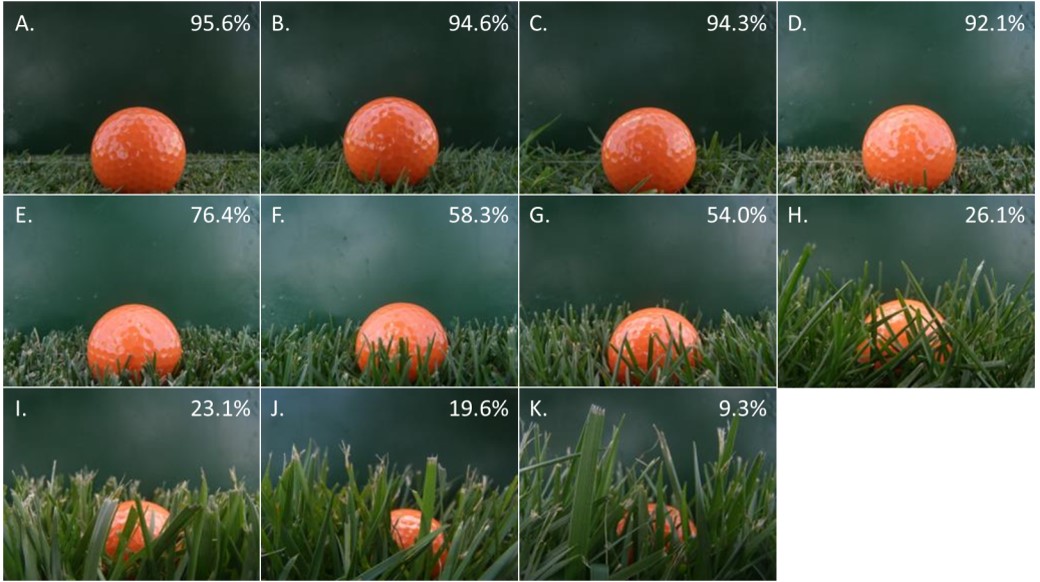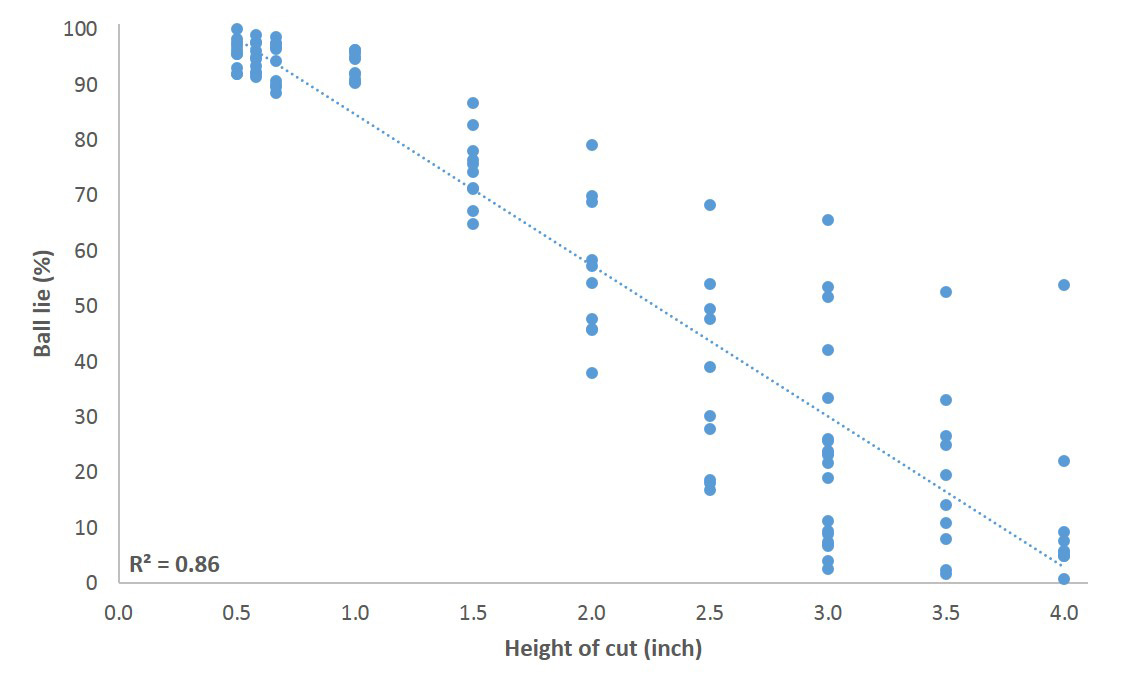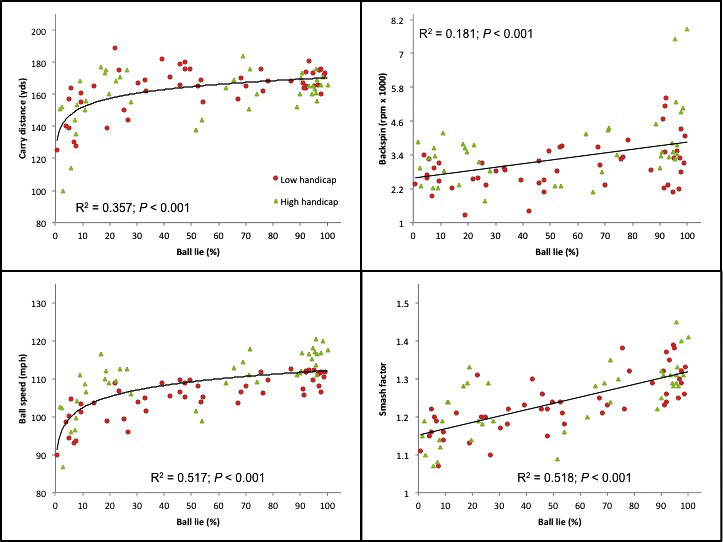Golf ball lie, mowing height and shot execution

Figure 1. Images collected prior to golf shot execution to analyze for ball lie (percent of ball exposed) showing (A) creeping bentgrass at 0.5 inch, (B) creeping bentgrass not mowed for two days, (C) creeping bentgrass not mowed for five days, (D) Kentucky bluegrass at 1.0 inch, (E) Kentucky bluegrass at 1.5 inches, (F) Kentucky bluegrass at 2.0 inches, (G) Kentucky bluegrass at 2.5 inches, (H) Kentucky bluegrass at 3.0 inches, (I) tall fescue at 3.0 inches, (J) tall fescue at 3.5 inches, and (K) tall fescue at 4.0 inches. Golf ball lie determined by digital image analysis is listed with each sub-image.
Anyone who has played golf knows that shots from the preferred lies of the fairway are more likely to be successful compared with a similar shot in the rough. Players finding themselves in the rough can use a variety of tips to help them advance the ball, including taking an extra club, choking up on the grip, using a shorter backswing, and even predicting how much grass will be trapped between the club face and ball.
These tips usually are equated to an ambiguous description of the rough, like “average” or “medium.” Even though these tips are based on experience, few studies have attempted to quantify the effects of rough on golf shot performance, or more specifically, correlate golf shot performance to ball lie or mowing height.
More important for golf course superintendents is this question: Could mowing height predict effects on the playability of the golf course? The objective of this study was to quantify the effect of golf ball lie on golf shot performance characteristics.
A study was conducted at the University of Arkansas Research and Extension Center in which two golfers of differing skill levels struck balls with 7-irons from creeping bentgrass at mowing heights of 0.5, 0.6 and 0.7 inch, Kentucky bluegrass at 1.0, 1.5, 2.0, 2.5, and 3.0 inches, and tall fescue at 3.0, 3.5, and 4.0 inches. The first golfer, denoted as low-handicap player (LH), had a USGA handicap index of scratch (0) and was a former Division I collegiate golfer. The second golfer had a USGA handicap index of 8 and participated in golf at the junior college level and was called a high-handicap player (HH). The two male golfers hit five shots per mowing height in random order. To ensure that ball lies were random, golf balls were dropped by each golfer from shoulder height and arm’s length to simulate taking a drop in accordance to USGA rule 20-2a. Golf shot performance characteristics such as carry distance, backspin, ball velocity, accuracy and others were measured by a launch monitor, and ball lie was quantified prior to golf shot execution using digital image analysis. Ball lie was determined as the percent of golf ball exposed in and above a turfgrass canopy (Figure 1).

Figure 2. Linear regression analysis comparing canopy height of turfgrass and ball lie collected from creeping bentgrass, Kentucky bluegrass and tall fescue plots at heights ranging from 0.5 to 4.0 inches.
Mowing height was correlated to golf ball lie (percent of golf ball exposed) as would be expected (Figure 2). The most interesting aspect of this correlation is how much ball lie varied as the mowing height increased. For example, ball lie of Kentucky bluegrass at 3.0 inches ranged from 66 percent to 9 percent of the ball exposed, while ball lie of creeping bentgrass at 0.5 inch ranged from 99 percent to 92 percent of ball exposed.
The variability of ball lie at the higher heights of cut may explain why prediction of the amount of grass that will be trapped between the club face and ball often is recommended. It also explains how carry distances can be reduced or increased (such as the case in flyer lies). In one instance during the study, the better of the two golfers had carry distances of 189 and 161 yards from Kentucky bluegrass at a height of cut of 3.0 inches, while the average carry distance from fairway lies at a height of cut of 0.5 inch was 164.8 yards.
Carry distance and ball lie

Figure 3. Linear and nonlinear regression analysis comparing golf shot parameters of carry distance, backspin, ball speed and smash factor for two golfers measured by a launch monitor to
golf ball lie demonstrated a significant effect on golf shots from ball lie.
Although variability in ball lie exists for taller cuts of turf and may produce flyer lies, there was a correlation between carry distance and ball lie. The relationship between the two was not simply linear. Instead, carry distance was much more greatly affected as less golf ball was exposed (Figure 3). For example, if the amount of ball exposed was 80 percent, carry distance would be reduced, on average, by 1.8 yards, and at 60 percent of the ball exposed, carry distance was reduced by 4.1 yards compared to a perfect lie of 100 percent ball exposure. In a linear relationship, it would be expected that a ball lie of 60 percent would reduce carry distance by 3.6 yards. Without having a digital camera and image analysis software on hand, a golfer may be interested to know what to expect based on something known, such as mowing height. Based on mowing height and compared to 100-percent ball exposure, it would be expected that at 1.0 inch, carry distance would be reduced by an average of 0.6 yards, or 1 foot 9.5 inches (Table 1). At a mowing height of 1.5 inches, carry distance would be reduced by an average of 2.3 yards. The difficulty of the golf course could be changed simply by increasing or decreasing the height of cut of the rough. By raising the mowing height from 1.5 to 2.0 inches, carry distance would be decreased by an additional 2.2 yards to 4.5 yards.
Ball speed followed a trend similar to carry distance in its relation to ball lie, but had a much stronger correlation. It would be expected that as mowing height increases and less golf ball is exposed, more turf leaves would prevent the transfer of energy between the club face and ball, and as ball speed is a component of carry distance, the ball should travel less. This is not always the case, as shot trajectory and backspin also play a significant role in carry distance.
The backspin story
In addition to affecting carry distance, golf ball lie has an effect on backspin generation in a linear relationship. As the amount of golf ball exposed decreases, average backspin also decreases, but the relationship between the two is weak and likely dependent on golfer ability and swing. There are many aspects of a golf swing that determine the amount of generated backspin. In this study, the golf balls used were of two-piece construction and designed to reduce spin and increase distance. Had premium balls been used, the amount of spin and relationship of spin to ball lie may have been different.
However, even with the type of ball used, the results from this study was similar to studies conducted by the USGA and R&A. For this study, in tall fescue or Kentucky bluegrass at 3.0 inches, a golfer could expect a decrease in backspin by an average of 25 percent. This reduction of spin could increase the difficulty of the golf course, especially for golf courses with firm and fast putting greens.
Effects on accuracy
Other common concerns in hitting from higher heights of cut are the effects on accuracy, the lateral distance from the target line. The results from this study indicated that only better players will notice a difference in the accuracy between fairway and rough. Correlation between ball lie and accuracy only occurred for LH. The better player averaged 4.5 yards away from the target when hitting from the fairway. His accuracy decreased by 5.2 yards from rough cut at 3.0 inches, which meant he averaged 9.7 yards from the pin. There was no relationship for the higher handicap player between ball lie and accuracy. This was likely due to a lack of consistency in hitting accurate shots, even from preferred ball lies.
Conventional thinking confirmed
The results of this study confirms conventional thinking on playing from the rough and demonstrated quantifiable effects of ball lie on golf shot performance characteristics. It shows that changing the height of cut of the rough can have a significant effect on the ability of a golfer to hit quality golf shots.
The results of this study may not be completely accurate for golf course superintendents managing warm-season grasses. Testing for this study was conducted on creeping bentgrass, Kentucky bluegrass and tall fescue, and may not be the same for bermudagrass, zoysiagrass or other warm-season species.
The ball lies measured in this study compared to previous work conducted by others indicate there may be differences. Average ball lie in this study for bermudagrass at 1.0-inch height of cut was slightly lower than ball lie measured for Kentucky bluegrass at the same height of cut (83 percent versus 93 percent). Another note of caution from this study is that the only club tested was a 7-iron, and while using other clubs may produce similar trends, the effects of ball lie may be different.
Dan Strunk, Ph.D., a former graduate student at the University of Arkansas, currently is a research associate at the University of Tennessee-Knoxville. Doug Karcher, Ph.D., and Mike Richardson, Ph.D., are turfgrass scientists at the University of Arkansas. Aaron Patton, Ph.D., is a turfgrass scientist at Purdue University. Joey Young, Ph.D., is a turfgrass scientist at Texas Tech University. You may reach Dan Strunk at wstrunk@utk.edu for more information.
Photo: Dan strunk









I had a 5 handicap at one time,age and injuries has changed that but one thing that has not changed is my belief that at a municipal golf course or public golf course the rough should not be higher than 1to 1.5 inches tall for the speed of play and the enjoyment of the amateur golfer. Players want to be able to find their balls as quick as possible so they are not slowing down play or becoming angry because they lose their balls in the rough.
They want to find the ball and enjoy the day and the game so they want to come back again. Golf has been and always will be a game and sport of different levels of expertise and from what I have seen in playing this game for over 50 years no one hits the fairways every time. Players complain about the pace of play all the time, amateurs are not pros and need to be able to enjoy themselves when they can play and hopefully come back again and again to hopefully get better. The more playable and enjoyable their experience the more they will play and the faster the pace of play the more rounds of golf will be played and that is good for everyone,I think,anyway.